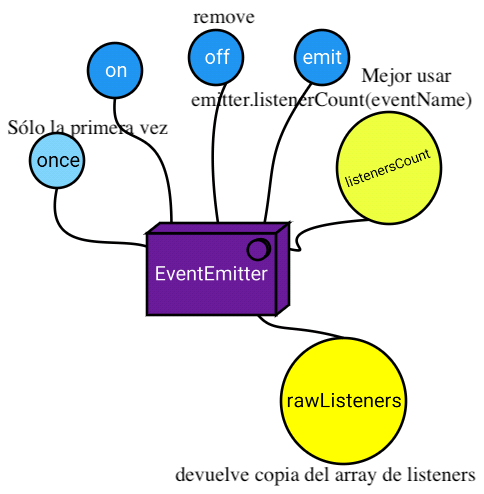Sistemas y Tecnologías Web: Servidor
Master de II. ULL. 1er cuatrimestre
Organization ULL-MII-SYTWS-2122 Classroom ULL-MII-SYTWS-2122 Campus Virtual SYTWS Chat Chat Profesor Casiano
Table of Contents
Events
Introducción
The Observer Pattern
The observer pattern is a software design pattern in which an object, called the subject, maintains a list of its dependents, called observers, and notifies them automatically of any state changes, usually by calling one of their methods.

See also
La Clase EventEmitter
- Algunos métodos de los objetos de la clase EventEmitter:

on
1
2
3
4
5
6
7
8
9
10
11
12
13
14
15
16
17
18
19
20
21
22
23
24
25
26
27
28
29
[~/.../p4-t2-networking/networking-with-sockets-chapter-3-crguezl(master)]$ node
Welcome to Node.js v12.10.0.
Type ".help" for more information.
> const {EventEmitter} = require("events")
undefined
> function c1() { console.log('an event occurred!');}
undefined
> function c2() { console.log('yet another event occurred!');}
undefined
> const myEmitter = new EventEmitter();
undefined
> myEmitter.on('eventOne', c1);
EventEmitter {
_events: [Object: null prototype] { eventOne: [Function: c1] },
_eventsCount: 1,
_maxListeners: undefined
}
> myEmitter.on('eventOne', c2)
EventEmitter {
_events: [Object: null prototype] {
eventOne: [ [Function: c1], [Function: c2] ]
},
_eventsCount: 1,
_maxListeners: undefined
}
> myEmitter.emit('eventOne');
an event occurred!
yet another event occurred!
true
once
1
2
3
4
5
6
7
8
9
10
11
12
13
14
15
16
> myEmitter.once('eventOnce', () => console.log('eventOnce once fired'));
EventEmitter {
_events: [Object: null prototype] {
eventOne: [ [Function: c1], [Function: c2] ],
eventOnce: [Function: bound onceWrapper] { listener: [Function] }
},
_eventsCount: 2,
_maxListeners: undefined
}
> myEmitter.emit('eventOnce');
eventOnce once fired
true
> myEmitter.emit('eventOnce'); // Returns true if the event had listeners, false otherwise.
false
> myEmitter.emit('eventOnce');
false
Argumentos
1
2
3
4
5
6
7
8
9
10
11
> myEmitter.on('status', (code, msg)=> console.log(`Got ${code} and ${msg}`));
EventEmitter {
_events: [Object: null prototype] {
eventOne: [ [Function: c1], [Function: c2] ],
status: [Function]
},
_eventsCount: 2,
_maxListeners: undefined
}
> myEmitter.emit('status', 200, 'ok'); // Synchronously calls each of the listeners registered for the event named 'status', in the order they were registered, passing the supplied arguments to each
Got 200 and ok
off / emitter.removeListener(eventName, listener)
Removes the specified listener from the listener array for the event named eventName.
1
2
3
4
5
6
7
8
9
10
11
12
> myEmitter.off('eventOne', c1);
EventEmitter {
_events: [Object: null prototype] {
eventOne: [Function: c2],
status: [Function]
},
_eventsCount: 2,
_maxListeners: undefined
}
> myEmitter.emit('eventOne');
yet another event occurred!
true
listenerCount and rawListeners
emitter.rawListeners(eventName) returns a copy of the array of listeners for the event named eventName, including any wrappers (such as those created by .once()).
1
2
3
4
> myEmitter.listenerCount('eventOne')
1
> myEmitter.rawListeners('eventOne')
[ [Function: c2] ]
Ejercicio
Escriba una clase WithTime que extienda la clase EventEmitter y cuyos objetos disponen de un método (new WithTime()).execute con una firma como esta:
1
2
3
const WithTime = require("./with-time.js");
const withTime = new WithTime();
withTime.execute(asyncFun, ...args);
Esto es, execute recibe como primer argumento una función asíncrona asyncfun y emite distintos tipos de eventos begin, end, error, etc, indicando los cambios de estado en la ejecución de asyncFun.
La firma de asyncFun es
1
asyncfun(..., cb)
Como es el convenio habitual en JS, se supone que la callback será llamada cb(err, data) por asyncfun cuando esta termina su tarea asíncrona. El primer parámetro err indica el error si lo hubo y el segundo data con el resultado de la operación asíncrona: cb(err, data).
Se pide que:
- La llamada
withTime.execute(asyncFun, ...args)emita eventosbeginyendseñalando el comienzo y final de la ejecución deasyncfun - Deberá así mismo emitir un evento
resultcon el resultado de la operación asíncrona al final de la misma. - Deberá emitir un evento
timeindicando el tiempo que ha tomado la ejecución en nanosegundos (puede usarprocess.hrtime.bigintpara ello)
Por ejemplo, un código como:
1
2
3
4
5
6
7
8
9
10
11
12
13
14
15
16
17
18
19
20
21
22
23
24
25
26
const inspect = require("util").inspect;
const ins = (x) => inspect(x, {depth: Infinity, colors: true});
const fetch = require("node-fetch");
const WithTime = require("./with-time.js");
const withTime = new WithTime();
withTime.on('begin', (label) => console.log('About to execute '+label));
withTime.on('end', (label) => console.log('Done with execution of '+label));
withTime.on('result', (label, data) => console.log('Function '+label+' produced:\n'+ins(data)));
withTime.on('error', (label, error) => console.log('Function '+label+' error:\n'+ins(error)));
withTime.on('time', (label, t) => console.log('Function '+label+' took '+t+' nanoseconds'));
const readFile = (url, cb) => {
fetch(url)
.then((resp) => resp.json())
.then(function(data) {
cb(null, data);
})
.catch(e => cb(`Buf! ${e}`));
}
withTime.execute(readFile, process.argv[2] || 'https://jsonplaceholder.typicode.com/posts/3');
Debería producir una salida como está:
1
2
3
4
5
6
7
8
9
10
11
12
13
About to execute readFile
Function readFile produced:
{
userId: 1,
id: 3,
title: 'ea molestias quasi exercitationem repellat qui ipsa sit aut',
body: 'et iusto sed quo iure\n' +
'voluptatem occaecati omnis eligendi aut ad\n' +
'voluptatem doloribus vel accusantium quis pariatur\n' +
'molestiae porro eius odio et labore et velit aut'
}
Function readFile took 331675217 nanoseconds
Done with execution of readFile
y si se producen errores una salida como esta:
1
2
3
4
➜ event-emitter-tutorial git:(master) ✗ node client.js no-existe
About to execute readFile
Function readFile error:
'Buf! TypeError: Only absolute URLs are supported'
Si quieres prácticar mas con los event emitters puedes realizar opcionalmente la práctica networking.